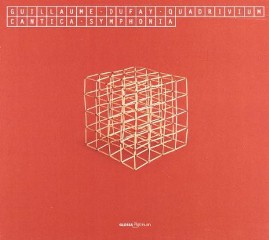Guillaume Dufay - Quadrivium (2005)
Guillaume Dufay - Quadrivium (2005)

1 Salve Flos Tuscae Gentis 7:44 2 Apostolo Glorioso, Da Dio Electo 3:25 3 Imperatrix Angelorum 4:48 4 Alma Redemptoris Mater (I) 4:16 5 Gaude Vigo, Mater Christi 4:39 6 Ecclesiae Militantis 5:42 7 Anima Mea Liquiefacta Est 5:52 8 Vasilissa, Ergo Gaude 3:11 9 Salve Regina 8:48 10 Inclita Stella Maris 4:25 11 Alma Redemptoris Mater (II) 4:26 12 Balsamus Et Munda Cera 4:24 13 Juvenis Qui Puellam 5:51 14 Flos Florum 3:56 15 Nuper Rosarum Flores 6:58 Cantica Symphonia (Ensemble)
This literally mind-boggling disc may be the first classical release to come packaged with its own 10-page essay by an Italian professor of mathematics. Although he certainly didn't think about it that way, Guillaume Dufay was a composer situated between the Middle Ages and the Renaissance; his songs breathed a new lyrical and text-expressive spirit, and his larger works linked the numerically oriented medieval isorhythm technique with the Renaissance cantus firmus technique of organizing a mass. His works seem to contain subtle, often hidden manipulations of mathematical proportions -- not surprising in itself, since proportion played an important part in musical, mathematical, and philosophical thinking of the day, and the entire notational system Dufay worked with was suffused with porportional possibilities. This album by the Italian vocal-instrumental group Cantica Symphonia takes off from the proportional aspect of large Dufay works like the motet Nuper rosarum flores, long thought to have been based on the proportions of the great cathedral of Florence but recently discovered to have probably been modeled on another building. The album was actually sponsored by the mathematics department of the University of Turin, and an essay by professor Guido Magnano explores the mathematical bases of the musical system Dufay knew. For the average listener the musical manifestations of these principles are going to be hard to hear sitting in front of your stereo; the chief interpretive decision made by Cantica Symphonia is to strive for a transparent texture, judiciously using a small instrumental ensemble to bring out structural details. Save for the fact that the voice parts are sung solo, it's a Renaissance performance in the classic "pure" mold. For the numerologically inclined or for the serious student of the Renaissance era, the disc is an interdisciplinary goldmine. Recorded in an Italian church, the disc matches its engineering to its aims, and the packaging by the Spanish label Glossa is uncommonly attractive. ---James Manheim, AllMusic Review
download (mp3 @320 kbs):
yandex mediafire ulozto gett bayfiles








